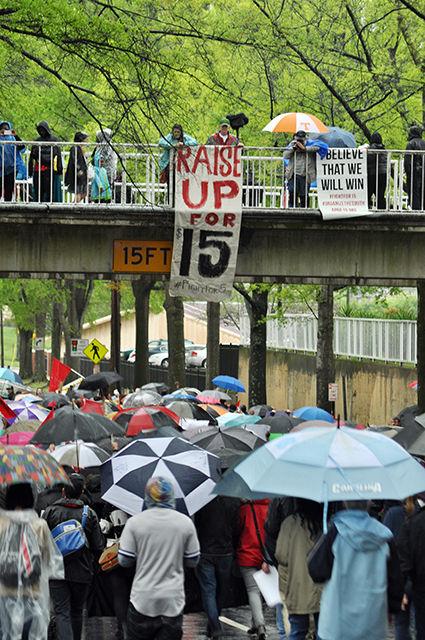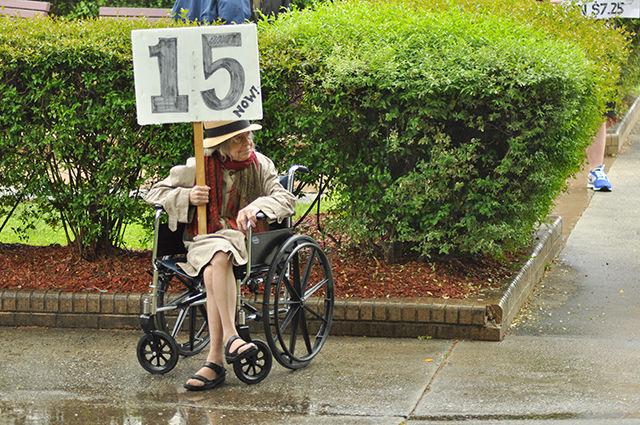Hundreds of protestors braced the rain to rally in support of raising the minimum wage to $15 an hour Wednesday, returning to the place where the Student Nonviolent Coordinating Committee was founded for a similar cause more than 50 years ago.
Students, professors and minimum-wage workers alike gathered in the Shaw University Quad in support of a higher minimum wage, union rights for workers and increased wages and job security for university adjunct faculty members, among other causes.
After a rally in the quad, which included speeches from minimum-wage workers, students, adjunct faculty members and the president of the North Carolina chapter of the NAACP Rev. William Barber III, demonstrators marched around the block next to Shaw, pausing at the McDonald’s on E. South Street to chant at the restaurant chain.
“McDonald’s McDonald’s, you’re no good, pay your workers like you should,” protesters urged.
For student demonstrators like Chantel Wright, a sophomore at Shaw University with history working at minimum-wage jobs, the cause hits close to home.
Wright’s mother lost her job when she was growing up in Atlanta and had to pick up a minimum-wage job to pay the bills, but it wasn’t enough.
“I had to try and pick up a job but it didn’t work out,” Wright said. “Bills kept stacking up.”
To this day, Wright’s mother is still making minimum wage, even though inflation continues to raise the cost of living each year.
“There is no reason why my mother is 41 years old and should still be making $7.25 at a bank,” Wright said. “If you are going to raise housing and food and everything, you need to raise minimum wage.”
The federal minimum wage peaked in 1968, when it was worth about $8.56 adjusted for inflation in 2012. The current $7.25 an hour minimum wage has lost 5.8 percent of its purchasing power due to the inflated cost of living, according to the Pew Research Center.
Breyonna Beatty, a sophomore at Shaw, said it isn’t fair to expect people to work three jobs to stay alive.
“A Chick-fil-A combo, if you upsize your drink, is $7.49,” Beatty said. “You have to work over an hour to get a meal at Chick-fil-A.”
More than half of fast-food employees and home health care aids receive government assistance, according to an analysis of census data by the University of California–Berkeley’s Center for Labor Research and Education.
Juliette Halen, a NC State student studying business administration, said students should care about wage issues beyond only wage and work toward making the system more equitable for everyone, including the problem of student debt.
According to the Wall Street Journal, the graduating class of 2014 was the most indebted class ever, with the average college graduate leaving school with an average of $33,000 in student loans.
After adjusting for inflation, the number is still nearly double the amount student borrowers owed 20 years ago, the WSJ reported.
“We are going to be getting out of college and have huge loans,” Halen said. “Most of us won’t have high-paying jobs. We’ll be ending up in a system that just doesn’t care about us.”
Camille Tate, a student at Appalachian State University who traveled more than three hours with a group of students to be a part of the protest, said students should pay particular attention to the need for a higher minimum wage.
“It’s an important issue for students,” Tate said. “It is impossible to pay tuition or rent or anything when you are still making $7.25 an hour.”
Protesting with low-wage workers and students were several adjunct faculty members from North Carolina universities demanding the schools pay them $15,000 per course taught.
An adjunct professor is a part-time university faculty member, often with asters or doctoral degree, who is hired by a university to teach courses on a per-class basis to save money.
Demetrius Noble, an adjunct professor of African American studies at UNCG, traveled an hour to join the rally and demand he and his fellow adjunct faculty members be compensated fairly.
Noble said many people don’t realize adjunct professors make less than minimum wage workers, depending on how few courses they teach, as most professors are paid about $2,000 to $3,000 per course.
Being an adjunct is a very tenuous position with very little job security, as adjunct positions are often negotiated semester to semester. Noble said he is fighting for adjunct faculty positions to be guaranteed at least a year-long contract with a minimum number of courses to help professors better count on the income they are planning to have to sustain themselves.
“I was just recently informed that I am not going to have a job in the fall because of budget cuts,” Noble said. “So, that is some income for me already lost and impacted.”
Because of the tenuous nature of the positions, Noble said many adjuncts did not come out to the rally for fear of the possibility that the university would retaliate against them.
Twenty five percent of adjunct college faculty members and their families receive public assistance in some form, such as Medicaid or food stamps, according to the census data.
“While they are fighting for $15 an hour, we are standing shoulder to shoulder as we are fighting for $15,000 a course,” Noble said.
The Student Nonviolent Coordinating Committee, or SNCC, formed out of a student meeting on the campus of Shaw University in 1960. The committee organized sit-ins, hosted voter registration drives and advocated for fair treatment of African American workers throughout the south, eventually becoming one of the most influential organizations in the American civil rights movement.
The demonstration was planned as part of a national day of protests being called the Fight for $15 and was organized by a Raleigh chapter of Raise Up, a worker’s rights advocacy group.
Jean Gross from Greenville sits with her sign before the Fight for $15 rally begins at Shaw University Wednesday afternoon. Rally participants protested for a higher minimum wage of $15 and union rights. Fast-food workers, childcare providers and educators were among those represented at the rally.









